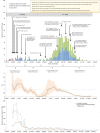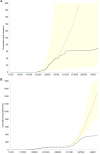Stringent containment measures without complete city lockdown to achieve low incidence and mortality across two waves of COVID-19 in Hong Kong
- PMID: 33028700
- PMCID: PMC7542625
- DOI: 10.1136/bmjgh-2020-003573
Stringent containment measures without complete city lockdown to achieve low incidence and mortality across two waves of COVID-19 in Hong Kong
Abstract
Introduction: An international city, Hong Kong, in proximity to the first epicentre of COVID- 19, experienced two epidemic waves with different importation pressure. We compared the epidemiological features of patients with COVID-19 in the context of containment policies between the first and second waves.
Methods: We retrieved information on the first 1038 cases detected in Hong Kong (23 January to 25 April 2020) to analyse the epidemiological characteristics including age/gender-specific incidence, clustering, reproduction number (Rt ) and containment delay; in relation to the containment measures implemented. Factors associated with containment delay were evaluated by multiple linear regression analysis with age, gender, epidemic wave and infection source as covariates. A time series of 5-day moving average was plotted to examine the changes across the two epidemic waves.
Results: The incidence and mortality (135.5 and 0.5 per 1 000 000 population) was among the lowest in the world. Aggressive escalation of border control correlated with reductions in Rt from 1.35 to 0.57 and 0.92 to 0.18, and aversions of 450 and 1650 local infections during the first and second waves, respectively. Implementing COVID-19 tests for overseas returners correlated with an upsurge of asymptomatic case detection, and shortened containment delay in the second wave. Medium-sized cluster events in the first wave were family gatherings, whereas those in the second wave were leisure activities among youngsters. Containment delay was associated with older age (adjusted OR (AOR)=1.01, 95% CI 1.00 to 1.02, p=0.040), male gender (AOR=1.41, 95% CI 1.02 to 1.96, p=0.039) and local cases (AOR=11.18, 95% CI 7.43 to 16.83, p<0.001), and with significant improvement in the second wave compared with the first wave (average: 6.8 vs 3.7 days). A higher incidence rate was observed for males, raising possibility of gender predilection in susceptibility of developing symptoms.
Conclusion: Prompt and stringent all-round containment strategies represent successful measures in pandemic control. These findings could inform formulation and implementation of pandemic mitigation strategies.
Keywords: SARS; epidemiology; public health; respiratory infections.
© Author(s) (or their employer(s)) 2020. Re-use permitted under CC BY-NC. No commercial re-use. See rights and permissions. Published by BMJ.
Conflict of interest statement
Competing interests: None declared.
Figures





References
-
- WHO Coronavirus disease (COVID-19) outbreak situation. Available: https://www.who.int/emergencies/diseases/novel-coronavirus-2019 [Accessed 31 May, 2020].
-
- Who press conference on may 25, 2020. Available: https://www.who.int/emergencies/diseases/novel-coronavirus-2019 [Accessed 16 Jun 2020].
-
- Population Estimates. Census and Statistics Department The government of the Hong Kong special administrative region. Available: https://www.censtatd.gov.hk/hkstat/sub/sp150.jsp?productCode=D5320189 [Accessed 01 Jun 2020].
MeSH terms
LinkOut - more resources
Full Text Sources
Miscellaneous
